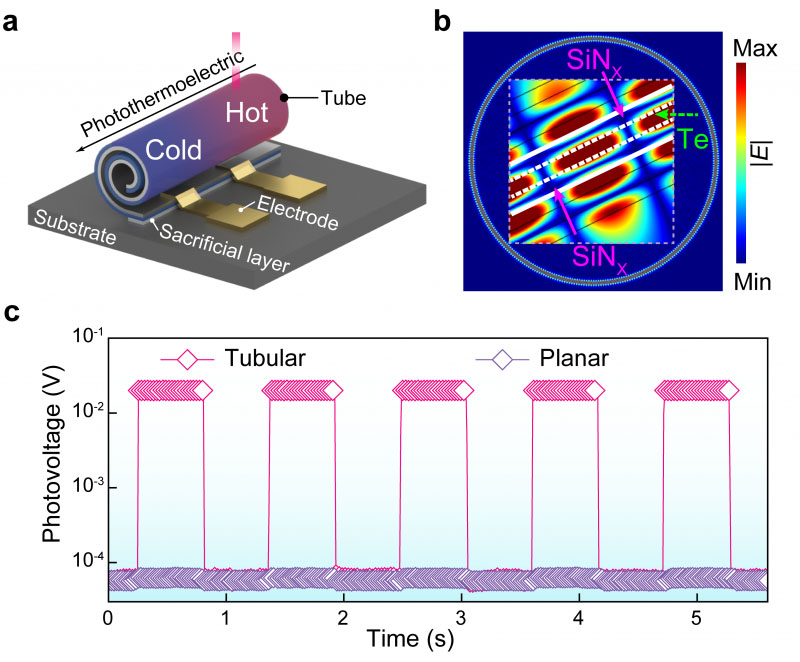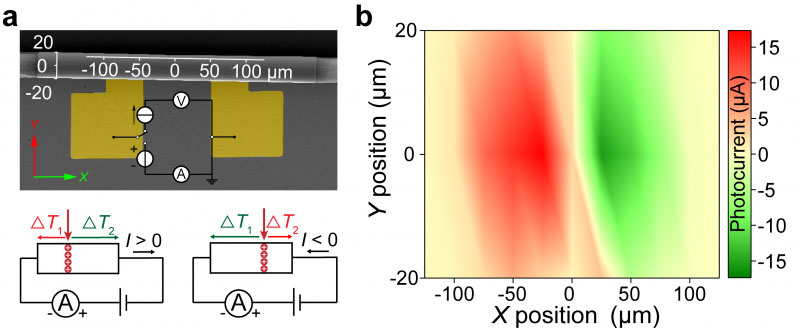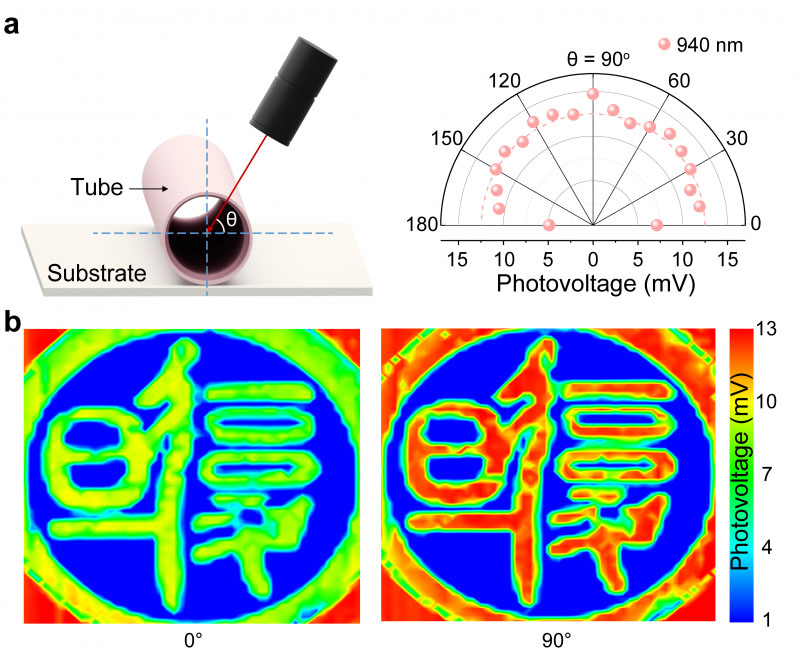| Sep 02, 2024 |
Energy localization in three-dimensional nanostructure
(Nanowerk News) Photothermoelectric (PTE) effect involves two energy conversion processes: photothermal conversion and thermoelectric effect. When the incident light is locally absorbed, a temperature difference is generated in thermoelectric material, and thus a voltage potential difference is established as an output electrical signal for photodetection.
|
|
To achieve higher detection performance, efficient approach for localizing both optical and thermal energies is crucial. However, due to the influence of substrate, it is a great challenge to promote the device performance and to study the coupling mechanism of multi-physical fields in micro/nano scale devices. With the tendency of on-chip integrated devices towards three-dimensional (3D) structure, the structure-performance relationship also needs to be explored. By using the self-rolled nanomembrane technology, the functional nanomembrane is separated from the substrate to construct an isolated 3D micro/nano structure.
|
|
The realization of light and heat energy localizations provides an ideal platform for studying the energy conversion in micro-/nano-devices and the output paves the way for the practical application in the corresponding fields.
|
|
This work (Light: Science & Applications, "Enhanced photothermoelectric conversion in self-rolled tellurium photodetector with geometry-induced energy localization") used Tellurium (Te) as the PTE active material, and 3D self-rolled tubular structure was prepared by releasing the Te nanomembrane from the substrate due to vertical strain gradient.
|
 |
| Figure 1: a) Schematic diagram of structure and working principle of self-rolled PTE detector; b) Simulated electric field distribution in the device under light illumination; c) Photovoltage-time curves of tubular detectors and planar detectors illuminated by a 940 nm laser. (© Light: Science & Applications)
|
|
Figure 1a shows the schematic of structure and working principle of a self-rolled PTE detector. In the tubular structure, photon energy is trapped in the Te nanomembrane with a higher refractive index, and the simulated results are shown in Figure 1b. The heat generated by optical absorption is localized in the isolated 3D tube wall with functional material to generate a larger temperature difference, thus creating a larger potential difference in thermoelectric conversion. The experimental results further verify that the energy localization effect in the isolated 3D tubular structure improves the photodetection performance: the self-driven photovoltage of the tubular detector is 307 times higher than that of the planar detector, as shown in Figure 1c.
|
|
In this work, incident light position was changed to verify the PTE effect and its position dependence. When the light spot deviates from the central position along the axial direction, reverse-directed photocurrent is observed (Figure 2a). For light spot moving perpendicular to the axial direction, the best photoresponse appears when the tubular detector was irradiated from the top along the tube diameter. Figure 2b shows the mapping results of the incident light position and the photocurrent, which helps to disclose the photo-thermo-electric coupling and conversion in the 3D structure.
|
 |
| Figure 2: a) Scanning electron microscopy image of tubular detector with the coordinate system, and diagram showing the photocurrent of the self-driven device dependent on the illumination position; b) Corresponding self-driven photocurrent mapping results. (© Light: Science & Applications)
|
|
Since the PTE detector outputs an electrical signal induced by the local temperature difference caused by incident light absorption, the response spectrum of PTE detector is theoretically not limited by the bandgap of the active material. The self-rolled PTE detector in this work also demonstrates broad-band photodetection from visible light to long-wave infrared region. The modulation of the rolling rotations of the tubular device is used to optimize the performance of the self-driven detector.
|
|
Furthermore, the unique 3D structure of the tubular detector is capable of conducting multidimensional detection. As shown in Figure 3a, the self-rolled detector demonstrated a wide-angle detection capability. In addition, the detector has a better response to the polarized light with electric field parallel to the tube axis induced by the cylinder symmetry, and polarimetric imaging with high resolution through single-pixel sensing is achieved, as shown in Figure 3b. The results demonstrate the multidimensional detection ability of self-rolled PTE detector to get the information of intensity and polarization.
|
 |
| Figure 3: a) Schematic diagram of wide-angle detection and angle-resolved photovoltage supported by rolled-up detector; b) Images attained by the self-rolled PTE detector with incident light’s polarization angles of 0° and 90° with respect to tube axis. (© Light: Science & Applications)
|
|
In summary, a novel 3D tubular PTE detector was designed and fabricated by combining the 3D self-rolled technology compatible with the mature semiconductor technology and the thermoelectric functional material. The 3D tubular structure effectively improved the light absorption and the heat localization, leading to the enhancement of the photo-thermo-electric conversion. The coupling mechanism of multi-physical fields was analyzed, and the detection performance was tuned by the change of geometric structure.
|
|
The self-rolled PTE detector has excellent performance such as high sensitivity, wide spectral response range, self-power, omni-directional detection, polarization imaging and so on. With the introduction of more functional materials and fine structures, the energy conversion mechanism in 3D micro/nano optoelectronic devices will be disclosed in depth, and the performance will be further optimized. These novel 3D devices will have a wider application in future on-chip integrated optoelectronic systems.
|



